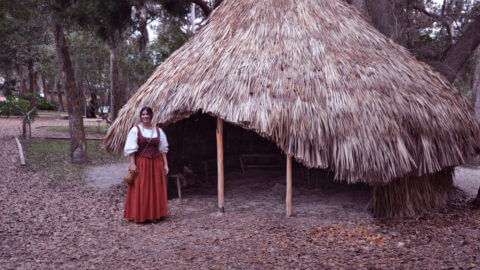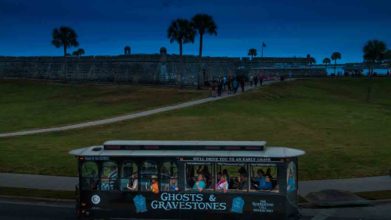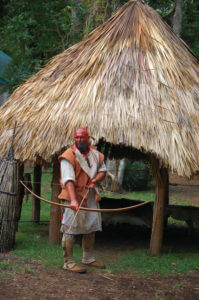The Timucua and the Village of Seloy

Artifacts discovered in archaeological digs provide important documentation of the presence of past civilizations and people. At the Fountain of Youth Archaeological Park, interesting artifacts uncovered by archaeological digs led to some of the park’s most interesting outdoor exhibits.
On-site digs have found evidence of the presence of the Timucua, Native Americans who began to occupy the region spreading from Central Florida to Southwest Georgia around 2400 B.C. As a loosely-knit confederation of tribes that shared common language, the Timucua were not bound politically as a common people. They traded with one another and went to war with one another.
Long before the arrival of Pedro Menendez de Aviles in 1565, the Timucua people lived in the St. Augustine area. They fished, hunted, cultivated corn, beans and squash. The principal chief of the St. Augustine region in 1565 was Seloy. His town has been located archaeologically on the grounds of what is today the Fountain of Youth Park, an area covering more than 12 acres, about 1 mile north of Castillo de San Marcos. Timucuan houses were usually circular and made of palm thatching. Timucuans used a wide variety of implements and ornaments made of bone, shell, stone and wood.
In September of 1565, Don Pedro Menendez de Avilas, Captain General of the Indies Fleet and Adelantado de Florida, and Chief Seloy of the Florida Timucua met. Menendez and his group of 800 colonists, including 24 women and an unknown number of African slaves, made their first settlement at Seloy’s village, and used Seloy’s council house as the first Spanish fort.
A letter written by Father Francisco Lopez de Mendoza Grajales, Chaplain of the Menendez fleet, documents the event (Lyon translation 1997:6.): “They went ashore and were well-received by the Indians, who gave them a very large house of a cacique [tribal chief] which is on the riverbank. And then Captains Patino and San Vicente, with strong industry and diligence, ordered a ditch and moat made around the house, with a rampart of earth and fagots…”






